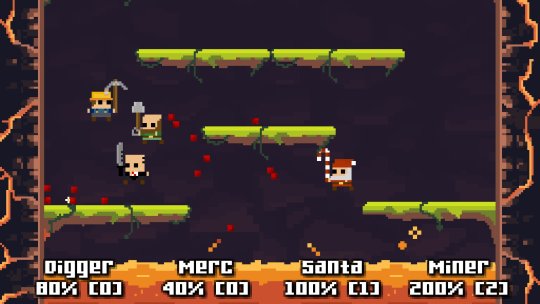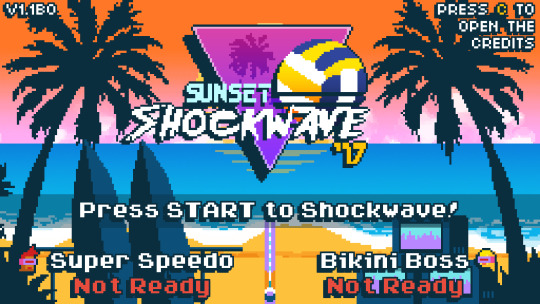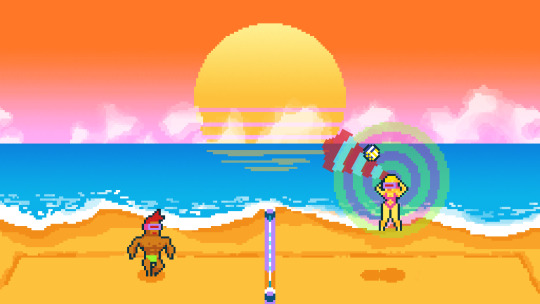#and if nothing else a split screen local multiplayer would still be great too!
Text
The Great Status Report - Part 2

And here we are, back with the second part of the catch-up status report. As I wrote in the conclusion of the previous half - which you can catch up with on this post – I wanted to split this publication in two separate halves to differentiate the settings in which each of the post’s games were developed on when compared to each other.
All the following games detailed in this blogpost were developed at Local Game Jams here in Portugal, as opposed being developed in Online Game Jams (such as Ludum Dare) as it was the case with the games mentioned in the previous half (excluding Blueprint Apocalypse which was developed as an university project). This means that the three games featured in this blogpost were all developed on actual jam sites in collaboration with other jammers present.
Local Game Jams are something I must suggest every person with an interest and passion in game development to participate on, more so if they have the availability to partake in one. It's a tremendous learning and networking experience, especially for someone who is getting started with game development. Of course, they're likewise always suited for someone that would like an against-the-clock game development challenge even if they've been already doing games either as an hobbyist or as a professional.

Everyone posing for the camera shot attempting to make unacknowledged viewers thinking they are actually working. Credits to Bold International for the picture's source.
Local Game Jams also a great opportunity to meet and network with other passionate game development enthusiasts, and sometimes, they're likewise a great place to meet and start working with potential teammates for future endeavors. Plus, at the end of it, overall practically everyone will have had a great time along with having a game that they can easily show off to other people and peers, or even place on their portfolio. They're also one of the settings in which people learn the most, being forced to think and research swiftly about what they wish to include in their jam game.
But I'll be leaving future explanations of why you should participate in Game Jams for a future post that I will be wanting to publish sometime in the future.
Let's start by putting the photo above into context. Back in November of last year, and after a year of barely any local Game Jams happening nearby in Lisbon, many of us were starting to question if there was still going to be another local game jam for the year, or if we would have wait until the Global Game Jam of the next year for another one.
Gladly, that's when Collide stepped in and announced the first edition of their very own Collide Game Jam, with the rather particular theme of challenging developers to do either a local multiplayer or VR experience, in conformance to the services the company offers. Having the thirst for more local jamming after my first Global Game Jam experience, I joined in and participated in it.

Due to us starting off unaware of the size of our scope, as well as some other issues that happened during the jam, some corners of the game had to suffer some cuts, such as the tittle screen of the game. Still looks pretty decent though, if you ask me!
During the jam, I teamed up with, at the time, two other students from another Game Development Bachelor degree here from Lisbon, David Filipe (Davidvfilipe) and João Almada (Joaogalmada), and, although the game's development during the progress of the jam wasn't exactly the smoothest due to various reasons, we were still able to close off the jam with a small and quirky multiplayer game that supported up to four players.
That game was The Shaft, a fast-paced arena platformer set in a volcano, where each player has to try and knock-back each of their opponents - other players - into the lava, all of this while trying to climb up the volcano themselves by jumping between platforms and avoiding the hot deadly pit. The more each player gets hit, the higher their knock-back percentage gets, making them progressively lose more of their air control the more they get hit. After a certain number of drops into the lava, the player gets eliminated until the next round. The last player standing wins.

All the characters were originally supposed to be digging stereotypes, however, somehow, Santa and an Agent 47 look-alike ended up getting stuck into the volcano too. We honestly have no clue on how that happened.
At least in the current present time, the game is not available on itch.io and we still haven't got plans for the future of the game, as all of us which worked on the game's development have been unavailable to continue working on it, at least for the time being. For the moment the project is considered archived, and simply a small game jam experiment we made. Although if you're still curious to see it in action, you can check out some of it's gameplay in the archive video of game jam's presentations.
After Collide Game Jam, things kept going forward, going through Ludum Dare 37 where Hyper Holomayhem was developed on, until we reached the most awaited yearly game jam all across the globe - Global Game Jam. If Ludum Dare is the leader of online game jams with up to 3000 submissions in a single edition, then Global Game Jam is the crown jewel, spanning across multiple jam sites spread all through out the world as it's held in January of every year. This year's edition was no exception, with Global Game Jam 2017 having a grand total and new record of 7260 submitted games!

A first-day picture of our jam site over at Universidade Europeia. We were only a handful of jammers at the site, but there were still some curious games coming out of it in the end. Credits to the university for the photo's source.
This year, in the attempt to create a more coherent and unified sign-up process for the participants for all of the jam sites in Lisbon, all of the places hosting the event in the city were grouped under as a single entity on the event's website - Global Game Jam 17 @ Lisboa - with each of the individual jam sites taking care of their own setup and accommodations. Participants were then split and subdivided in groups across the various sites, depending on both their preference and skill.
Being a student at Universidade Europeia I ended up by staying on that jam site where I also contributed on setting up some of the aspects and organization of the place, checking what needed to be placed on the site and the type of commodities required to setup and host the participants. Although some details needed some persistence, we ended up hosting a small group of about 20 jammers, all satisfied with general organization of the site. This also helped the university test the viability of hosting larger game jams and events, as you'll see further down in this post.

If the image above doesn't just scream to the theme of Waves at you by just looking at it, we don't know how else we could have tackled the theme.
Similarly to Ludum Dare and most game jams, the challenge in Global Game Jam comes from having to create a game around a specific theme that's announced during it's keynote. This year, the jam's theme was Waves, and, forming group with José Castanheira (JCCCastanheira), another game jam aficionado, and with a soundtrack by Pedro Costa (Dainomyte), we created one of the game jam games which we are most proud of - Sunset Shockwave - in which we mixed two different interpretations of the theme - the waves hitting a beach shore and brain waves - to create an unique experience.
Likewise to the previous game, Sunset Shockwave is a local multiplayer game designed specifically to be played competitively by two players. Set in an alternate timeline, the rise of the 80s has lead to the creation of a new technology known as the Shockwave Headgear, a special set of accessories that allow users to convert brain waves into kinetic forces and which was proven to be a success in sports.
The game tackles one of these sports, Shockwave Volleyball, and has players using kinetic forces in order to shockwave a volleyball between two sides of a field, with aspects such as the shockwave's direction and force, together with the headgear's cool-down leading to multiple competitive aspects and decisions made by the players on a very short period of time.

Different gameplay aspects, such as the direction of the player's shockwave together with the amount of time the shockwave is active can lead to different ball trajectories and applied force, which diversify the different possible outcomes of a round.
Sunset Shockwave has been a great success at events we have taken the game too, one example being 4Gamers. Being a multiplayer based game, it's the perfect type of game to be present at meetups and conferences with large groups of people, as players are able to quickly grab another person and immediately set out to play a multiplayer match with. We were even featured by a portuguese blog, Vida Extra, in which the writer considered the game to be one of their newfound favorites.
One curious aspect of the games nature is that all the players picking it up for the first time will always have an hard-time on their first match, but immediately on the round afterwards, they'll be playing it with the same skill as a player with multiple matches of expertise.
For those that are unable to play the game in public events, or would like to play with another person at home, the game is available for free on itch.io, once again for all major desktop platforms. Although the game can be played by sharing a keyboard between two players, we recommend using two separate controllers for the best experience.
We have been having internal conversations about what we would like to do in regards to the future of the Sunset Shockwave, given it's overwhelmingly positive reception, however, at this point in time we still have nothing to announce. I would personally recommend you to keep in touch, though!

Full-house at Games for Good, the event described in the next section of this post. Probably also the biggest keynote I have seen being done for a game jam yet. Credits to the university for the photo's source.
Afterwards, jumping all the way from January over to May, we arrive at the last local game jam I have participated in as off recently. As I've mentioned earlier, after experimenting with hosting Global Game Jam at Universidade Europeia, the university wanted to attempt and host a bigger-scale event of their own whilst attempting to do a different kind of game jam that the ones previously hosted and done throughout Portugal.
Instead of being a game jam focused on the participants experimenting with a specific theme, or creating mostly entertainment-based games, Games For Good instead challenged participants to develop concepts and games based around the different goals and causes of multiple institutions (most of them being NGOs). These institutions were invited to be partners of the event and, during the keynote, presented participants with an overview of their mission together with several concepts and challenges that jammers could pick from, mutate, and develop according to their own vision.

Being a different kind of game jam, and being one mostly about experimenting with the challenges purposed by the NGOs, we mostly focused our development around creating an example of what the full-fledged project would look like, rather than creating a self-contained fully-polished experience.
Being interested on the jam's concept ,and being a student of the university, it was also a must-participate. Teaming up with both Pedro Pais (Cheesesky2) and João Graça (Marching Sun) as Team Samurai (since Samurai Jack was airing at the time), we developed a project based on the challenge of creating an educational project together with the association Florescer, a small association with the mission of allowing kids to learn and experiment while outside of their classrooms.
Although we had various hiccups creating a game design during the early concept phase due to the nature of the jam, we eventually settled on a concept known as Reis de Portugal - O Jogo de Cartas (literally translated to Kings of Portugal - The Trading Card Game).
With the concept, we experimented with the idea of a trading card game that could be played by two players on a mobile device based around the medieval age of Portugal, featuring various kings and well-known figures and social statutes of early Portuguese history. The full-fledged idea behind the game's design was that the game would be used by teachers to incentive the learning of a specific school subject (in our case, History) where the pupils would be able to unlock different cards and game features by achieving certain objectives in the real-world.

A small flaw we didn't notice during the project's development was that we unconsciously made half of the game's text in English, and another half in Portuguese. Oops.
By the end of the jam, we were awarded with the jam's third place by the event's jury. Given how the project was of an experimental nature and the early issues we had in coming up with a solid game concept, we were honestly flattered to receive such a prize.
Although we were going to create an itch.io page for the prototype itself, we eventually had to post-pone it's creation due to classes and personal projects. I still recommend you to personally checkout the event's winner, The Invisible 11% on their own game page though!

Another photograph of the full-house at Games for Good, right before the beginning of the keynote. I personally didn't write about it on the event's description but the jam also featured a Junior component for middle and high school students to participate on. Credits to the university for the photo's source.
Whew! And there's that! With this second part of this status report, most of the stuff that was pending to be announced and talked about in this blog from up to last year has finally been posted off! This of course, with the exception of our Ludum Dare 38 game, Petty Puny Planet 38, in which I will be making it's very own dedicated blog-post in the future. However, I wanted to make sure these less talked games and jams I don't tend to feature or talk about as much on social media were archived and stored here in this set of blogposts even if they ended up becoming quite extensive.
Being honest, this second blog post was originally going to be published and written much earlier, all the way back in April when the first part was published. However, given my academic life together with other personal life related distractions and projects, setting up time and a clear mind to fully write about these past projects hasn't been the easiest of process and constantly being delayed.
I don't like to make empty promises, or talk about how stuff keeps constantly being postponed, and going forward, I'd like to avoid such extensive and spaced publications in this blog and settle on a more methodological publication system, especially with the different games and features that will be coming in the future.
As such, I'll be aiming to start writing more frequent, shorter, blogposts both about the current projects in-development and about other subjects, both game development related and not, that I feel passionate about and believe would fit in the context of this page. I don't know if I'll be able to keep up with the promise, but I'll be aiming for it!

Screenshot of Petty Puny Planet 38, the project we have developed for Ludum Dare 38 and which will be getting it's own dedicated blogpost in the future, expect-ably soon.
For those who have read all the way until the end, thank you for reading and sticking around until now, and I hope you keep up with what is yet to come. Although there's this whole situation about spaced-out blogposts and what not, I still occasionally tweet about what's been happening on my Personal Twitter, and if you'd like a more condensed and shorter version of what is currently going on, I'd suggest you to follow me there!
#gamedev#event#game jam#project#university#the shaft#sunset shockwave#kings of portugal#petty puny planet#great status report
1 note
·
View note